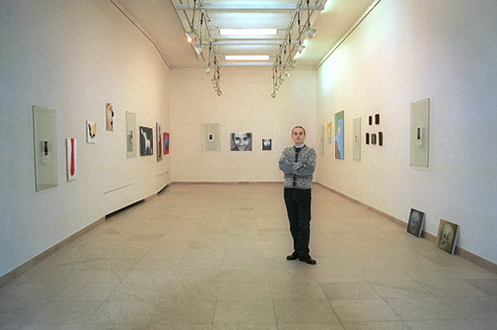
Dejan Grba, Stealth, Dom omladine Gallery set, Belgrade, 1995.
Dejan Grba’s curatorial project Stealth features six artists with disparate poetics and approaches to art, but akin in their transparently hidden position in the art-world. If submitted to formal analysis, their works provide the basis for narratives of the return to figure (characteristic of all exhibitors except Irina Culic), portrait (Petronijević as well as Crnčević with Gangrene), materialized corporeality (Irina Culic), and of the body as such with its functions and dysfunctions (Crnčević). Nevertheless, the very concept of this show, expressed by the metaphor of McTiernan’s Predator, shifts the interpretation of this project toward, on one hand, such dichotomies as network/individual, appearance/disappearance, exclusion/inclusion and regularity/anomaly, and, on the other, toward the problem of elusive identity.
Visitors of this show miss the identities of represented artists just as Predator’s victims miss his. The exhibited works are marked with clearly distinguishable visual characters, the exhibitors’ biographic data are provided but instead of their ‘real’ photographs we are presented with the visuals of the only persons in our era of total networking who are capable for maintaining their artistic production from the position of loneliness, anonymity and isolation – the mentally ill. This distress of common relationship between artists’ visual, biographic and stylistic identities creates a sense of evasiveness, followed by the logical question: ‘Who are these artists?’ The answer is, certainly, that each of them is stealth, and that they are all stealth. Their identity is (quite overtly) concealed by their identification with some other identities, and their loneliness and exclusion from the network are possible only by acquiring the group identity and by entering the art network under guise of changed individual identity. Their appearance on the art scene is necessitated by their hiding which is necessitated by their previous or concurrent appearance on the scene, that is, by their self-proclamation as participants of the scene. This strategy is parallel to that of Christifor Columbus in Jacques Besse’s Dancer who manages to suppress the mutiny and to become an admiral only by simulating a false admiral who simulates the dancing whore. That simulation is equal to empathy or identification – it provides an identity in the way as described by the unnamable hero of Beckett’s The Unnamable: ‘Maybe I will, by wanting to be Worm, finally be Mahood! Then I will only have to be Worm. And that I will for sure manage to be by trying to be Tartempion. Then I will have to be only Tartempion’. He can be something only if he is something else – he can be Mahood only if he is Worm, he can be Worm only if he is Tartempion – if he acquires one identity after another, while not denying any. ‘He is a girl only if he is an old man who simulates the girl or, rather, if he is someone who simulates an old man who simulates the girl. Or, rather, if he is someone who simulates someone who, etc’ say Deleuze & Guattari. In this sense, every identity lapses and reveals some other identity that is actually a simulation of that or some other identity, or of itself. Stealth strategy thus becomes adequate to the schizophrenic’s strategy in Deleuze-Guattari sense, revealing this project as schizophrenic so that its curator, if asked who these artists were, can never answer in oedipal way, with ‘Me’.
Stevan Vuković, Identity Slip, Stealth exhibition catalogue, Dom omladine Gallery, Belgrade, 1995.